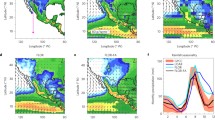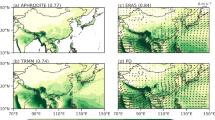Abstract
Increased atmospheric carbon dioxide concentration provided warmer atmospheric temperature and higher atmospheric water vapor content, but not necessarily more precipitation. A set of experiments performed with a state-of-the-art coupled general circulation model forced with increased atmospheric CO2 concentration (2, 4 and 16 times the present-day mean value) were analyzed and compared with a control experiment to evaluate the effect of increased CO2 levels on monsoons. Generally, the monsoon precipitation responses to CO2 forcing are largest if extreme concentrations of carbon dioxide are used, but they are not necessarly proportional to the forcing applied. In fact, despite a common response in terms of an atmospheric water vapor increase to the atmospheric warming, two out of the six monsoons studied simulate less or equal summer mean precipitation in the 16×CO2 experiment compared to the intermediate sensitivity experiments. The precipitation differences between CO2 sensitivity experiments and CTRL have been investigated specifying the contribution of thermodynamic and purely dynamic processes. As a general rule, the differences depending on the atmospheric moisture content changes (thermodynamic component) are large and positive, and they tend to be damped by the dynamic component associated with the changes in the vertical velocity. However, differences are observed among monsoons in terms of the role played by other terms (like moisture advection and evaporation) in shaping the precipitation changes in warmer climates. The precipitation increase, even if weak, occurs despite a weakening of the mean circulation in the monsoon regions (“precipitation-wind paradox”). In particular, the tropical east-west Walker circulation is reduced, as found from velocity potential analysis. The meridional component of the monsoon circulation is changed as well, with larger (smaller) meridional (vertical) scales.














Similar content being viewed by others
References
Adams DK, Comrie AC (1997) The North American monsoon. Bull Am Meteor Soc 78:2197–2213
Allen MR, Ingram WJ (2002) Constraints on future changes in climate and the hydrologic cycle. Nature 419:224–232
Annamalai H, Hamilton K, Sperber KR (2007) The South Asian summer monsoon and its relationship with ENSO in the IPCC AR4 simulations. J Clim 20:1071–1092
Ashfaq M, Shi Y, Tung WW, Trapp RJ, Gao XJ, Pal JS, Diffenbaugh NS (2009) Suppression of south Asian summer monsoon precipitation in the 21st century. Geophys Res Lett 36:L01704. doi:10.1029/2008GL036500
Bellucci A, Gualdi S, Navarra A (2010) The double-ITCZ syndrome in coupled general circulation models: the role of large-scale vertical circulation regimes. J Clim 23:1127–1145
Boer GJ (1993) Climate change and the regulation of the surface moisture and energy budgets. Clim Dyn 8:225–239
Bolton D (1980) The computation of equivalent potential temperature. Mon Weather Rev 108:1046–1053
Camberlin P (1997) Rainfall anomalies in the source region of the Nile and their connection with the Indian summer monsoon. J Clim 10:1380–1392
Cherchi A, Navarra A (2007) Sensitivity of the Asian summer monsoon to the horizontal resolution: differences between AMIP-type and coupled model experiments. Clim Dyn 28:273–290
Cherchi A, Masina S, Navarra A (2008) Impact of extreme CO2 levels on tropical climate: A CGCM study. Clim Dyn 31:743–758
Chou C, Neelin JD (2004) Mechanisms of global warming impacts on regional tropical precipitation. J Clim 17:2688–2701
Chou C, Neelin JD, Chen C-A, Tu J-Y (2009) Evaluating the “rich-get-richer” mechanism in tropical precipitation change under global warming. J Clim 22:1982–2005
Dai A (2006) Recent climatology, variability and trends in global surface humidity. J Clim 19:3589–3606
de Szoeke SP, Xie SP (2008) The tropical eastern Pacific seasonal cycle: assessment of errors and mechanisms in IPCC AR4 coupled ocean-atmosphere general circulation models. J Clim 21:2573–2590
Emori S, Brown SJ (2005) Dynamic and thermodynamic changes in mean and extreme precipitation under changed climate. Geophys Res Lett 32. doi:10.129/2005GL023272
Forster P, Ramaswamy V, Artaxo P, Berntsen T, Betts R, Fahey DW, Haywood J, Lean J, Lowe DC, Myhre G, Nganga J, Prinn R, Raga G, Schulz M, Van Dorland R (2007) Changes in atmospheric constituents and in radiative forcing. In: Solomon S, Qin D, Manning M, Chen Z, Marquis M, Averyt KB, Tignor M, Miller HL (eds) Climate change 2007: the physical science basis. contribution of working group I to the fourth assessment report of the intergovernmental panel on climate change. Cambridge University Press, Cambridge
Gill AF (1980) Some simple solutions for heat induced tropical circulations. Q J R Meteorol Soc 106:447–462
Gualdi S, Scoccimarro E, Navarra A (2008) Changes in tropical cyclone activity due to global warming: results from a high-resolution coupled general circulation model. J Clim 21:5204–5228
Gualdi S, Navarra A, Guilyardi E, Delecluse P (2003) Assessment of the tropical Indo-Pacific climate in the SINTEX CGCM. Ann Geophys 46:1–26
Held IM, Soden BJ (2006) Robust responses of the hydrological cycle to global warming. J Clim 19:5686–5699
Kalnay E, Kanamitsu M, Kistler R et al (1996) The NCEP/NCAR 40-Year Reanalysis Project. Bull Am Meteorol Soc 77:437–471
Lau KM, Kim K-M, Lee M-I (2007) Characteristics of diurnal and seasonal cycles in global monsoon systems. J Meteorol Soc Jpn 85A:403–416
Lin JL (2007) The double-ITCZ problem in IPCC AR4 coupled GCMs: Ocean-atmosphere feedback analysis. J Clim 20:4497–4925
Liu X, Yanai M (2001) Relationship between the Indian monsoon rainfall and the tropospheric temperature over the Eurasian continent. Q J R Meteorol Soc 127:909–937
Lu J, Vecchi GA, Reichler T (2007) Expansion of the Hadley cell under global warming. Geophys Res Lett 34:L06085. doi:10.1029/2006GL028443
Madec G, Delecluse P, Imbard M, Levy C (1998) OPA version 8.1 Ocean General Circulation Model reference manual. Tech Rep LODYC/IPSL Note 11
May W (2004) Potential future changes in the Indian summer monsoon due to greenhouse warming: analysis of mechanisms in a global time-slice experiment. Clim Dyn 22:389–414
Meehl GA (1992) Effect of tropical topography on global climate. Annu Rev Earth Planet Sci 20:85–112
Meehl GA, Washington WM (1993) South Asian summer monsoon variability in a model with doubled atmospheric carbon dioxide concentration. Science 260:1101–1104
Morcrette JJ (1984) Sur la paramétrisation du rayonnement dans le modèles de la circulation générale atmosphérique. Thèse de Doctorat d’Etat, Université de Sciences et Techniques de Lille 630
Morcrette JJ, Fouquart Y (1985) On systematic errors in parameterized calculations of longwave radiation transfer. Q J R Meteorol Soc 111:691–708
Murakami T, Matsumoto J (1994) Summer monsoon over the Asian continent and Western North Pacific. J Meteorol Soc Jpn 72:719–745
Peixoto JP, Oort AH (1992) Physics of climate. Am Inst of Physics 520
Richter I, Xie S-P (2008) Muted precipitation increase in global warming simulations: A surface evaporation perspective. J Geophys Res 113:D24118. doi:10.1029/2008JD010561
Roeckner E, Arpe K, Bengtsson L, Christoph M, Claussen M, Dümenil L, Esch M, Giorgetta M, Schlese U, Schulzweida U (1996) The Atmospheric general circulation Model ECHAM4: Model description and simulation of present-day climate. Max-Planck Institut für Meteorologie, Report no. 218, Hamburg, p 86
Seidel DJ, Fu Q, Randel WJ, Reichler TJ (2008) Widening of the tropical belt in a changing climate. Nat Geosci 1:21–24
Sun Y, Solomon S, Dai A, Portmann RW (2007) How often will it rain? J Clim 20:4801–4818
Thorncroft C, Lamb P (2005) The West African monsoon. WMO/TD no. 1266
Ueda H, Iwai A, Kuwako K, Hori ME (2006) Impact of anthropogenic forcing on the Asian summer monsoon as simulated by eight GCMs. Geophys Res Lett 33:L06703. doi:10.1029/2005GL025336
Vecchi GA, Soden BJ (2007) Global warming and the weakening of the tropical circulation. J Clim 20:4316–4340
Vecchi GA, Soden BJ, Wittenberg AT, Held IM, Leetma A, Harrison MJ (2006) Weakening of tropical Pacific atmospheric circulation due to anthropogenic forcing. Nature 441:73–76
Wang B, Ding Q (2008) Global monsoon: dominant mode of annual variation in the tropics. Dyn Atm Oc 44:165–183
Wang B, Li T, Ding Y, Zhang R, Wang H (2005) East Asian–Western North Pacific Monsoon: a distinctive component of the Asian–Australian monsoon system. In: The global monsoon system: research and forecast WMO/TD No.1266
Webster PJ (1972) Response of the tropical atmosphere to local steady forcing. Mon Weather Rev 100:518–541
Webster PJ (1987) The elementary monsoon. In: Fein JS, Stephens PL (eds) Monsoons. Wiley-Interscience, New York
Webster PJ, Yang S (1992) Monsoon and ENSO: Selectively interactive systems. Q J R Meteor Soc 118:877–926
Webster PJ, Magana V, Palmer TN, Shukla J and co-authors (1998) Monsoons: processes, predictability and the prospects for prediction. J Geophys Res 103:14451–14510
Wu R (2008) Possible role of the Indian ocean in the in-phase transition of the Indian-to-Australian summer monsoon. J Clim 21:5727–5741
Xie P, Arkin P (1997) Global precipitation: a 17-year monthly analysis based on gauge observations, satellite estimates, and numerical model outputs. Bull Am Meteorol Soc 78:2539–2558
Zhou J, Lau KM (2001) Principal modes of interannual and decadal variability of summer rainfall over South America. Int J Climatol 21:1623–1644
Zhou TJ, Yu RC, Li HM, Wang B (2008) Ocean forcing to changes in global monsoon precipitation over the recent half century. J Clim 21:3833–3852
Acknowledgments
This work was done in the “Numerical Application and Scenarios” division of CMCC in the framework of the activity “Understanding of the climate system.” We are grateful to the anonymous reviewers whose comments greatly improved the analysis and to C. Cagnazzo for her advice related to radiative issues. A. Cherchi thanks G.A. Vecchi and H. Annamalai for useful discussion and suggestions in the preliminary part of the study.
Author information
Authors and Affiliations
Corresponding author
Appendix: Computation of the relative humidity
Appendix: Computation of the relative humidity
The relative humidity as a measure of the balance between the water-holding capacity of the atmosphere and the tropospheric water vapor content has been computed by means of the formula:
where q is the specific humidity (in g kg−1) and q s is the saturation-specific humidity. The saturation-specific humidity may be approximated as a function of the saturation vapor pressure e s and of the atmospheric pressure p through
where 0.622 is the ratio of the gas constant of dry air and of water vapor (R d/R v). The saturation vapor pressure can be expressed as a function of temperature only by means of empirical formulae, e.g.:
where T is the temperature expressed in °C (Bolton 1980). RH has been computed from the surface up to 200 mb and then averaged in the tropospheric column.
Rights and permissions
About this article
Cite this article
Cherchi, A., Alessandri, A., Masina, S. et al. Effects of increased CO2 levels on monsoons. Clim Dyn 37, 83–101 (2011). https://doi.org/10.1007/s00382-010-0801-7
Received:
Accepted:
Published:
Issue Date:
DOI: https://doi.org/10.1007/s00382-010-0801-7




